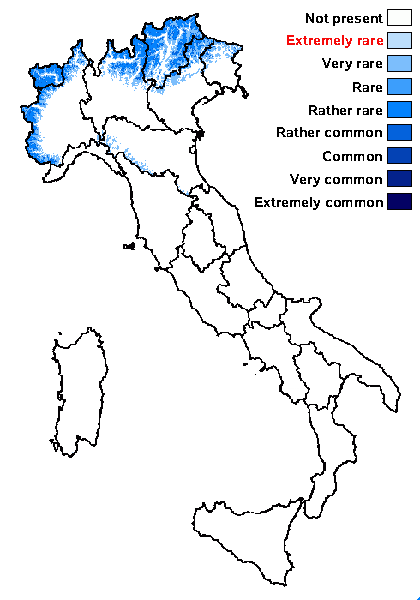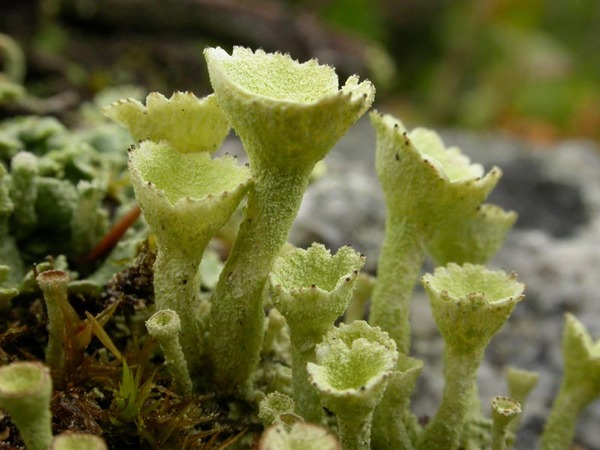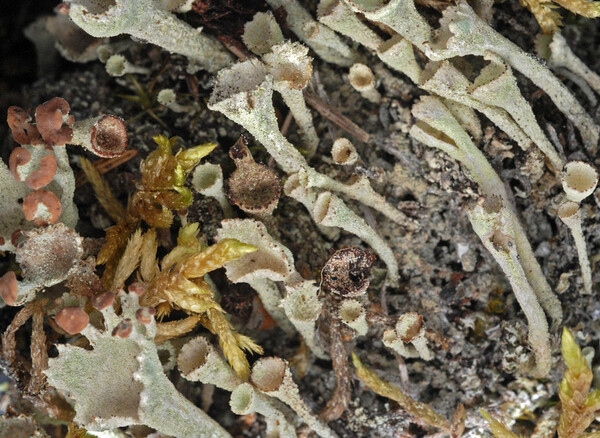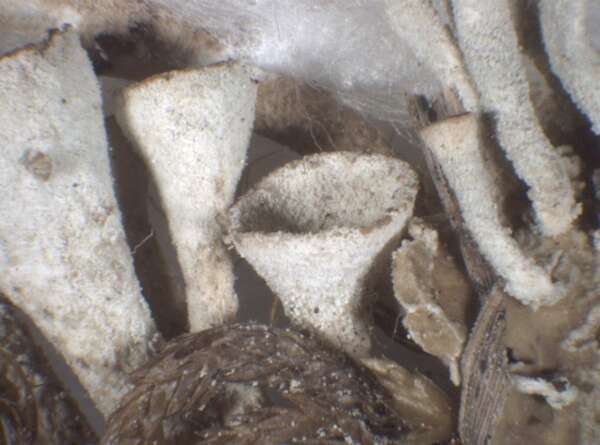Cladonia carneola (Fr.) Fr.
Lichenogr. Eur. Ref.: 233, 1831. Basionym: Cenomyce carneola Fr. - Sched. Crit. Lich. Suec., 3-4: 23, 1825.
Synonyms:
Distribution: N - Frl (Tretiach & Molaro 2007), Ven (Caniglia & al. 1999, Nascimbene & Caniglia 2003c), TAA (Nascimbene & al. 2007b, 2922, Watson 2014, Nimis & al. 2015), Lomb (Rivellini 1994, Rivellini & Valcuvia 1996, Rossi & al. 1998, Valcuvia & al. 2000d, Nascimbene & al. 2006e), Piem (Isocrono & al. 2004), VA (Valcuvia 2000), Emil (Fariselli & al. 2020).
Description: Primary thallus squamulose, the squamules persistent or usually disappearing, small and often inconspicuous, 1-3(-4) mm long and wide, rounded at apices, yellowish-greyish-green above, white to yellowish beneath, darkening towards the base. Podetia hollow inside, yellowish-greyish-green, not melanotic at base, usually esquamulose or with a few squamules the base, 0.5-3(-5) cm tall, entirely farinose-sorediate (soredia 20-40 μm in diam.), with regular, up to 7 mm wide cups abruptly tapering to a 0.2-2 mm thick stalk, the margins of cups often toothed, sometimes proliferating. Apothecia not very frequent, located on the margins of cups, waxy yellow to very pale brown, convex and stipitate. Asci 8-spored, clavate, thickened at apex, with a K/I+ blue tholus and a K/I+ strongly blue outer gelatinous sheath, Cladonia-type. Ascospores 1-celled, hyaline, ellipsoid. Pycnidia frequent on the marginal teeth of cups, pale brown, with a colourless jelly. Conidia hyaline, curved. Photobiont chlorococcoid. Spot tests: K-, C-, KC+ yellowish, P-, UV-. Chemistry: usnic acid, zeorin (the latter visible as a layer of crystals on the surface, especially in herbarium specimens), rarely with additional barbatic acid.Note: a circumpolar, mainly boreal-montane to subarctic lichen found on rotting wood and soil rich in humus in open montane to subalpine woodlands, sometimes reaching the Alpine belt.
Growth form: Fruticose
Substrata: lignum, soil, terricolous mosses, and plant debris
Photobiont: green algae other than Trentepohlia
Reproductive strategy: mainly asexual, by soredia, or soredia-like structures (e.g. blastidia)
Commonnes-rarity: (info)
Alpine belt: rather rare
Subalpine belt: rather common
Oromediterranean belt: absent
Montane belt: very rare
Submediterranean belt: absent
Padanian area: absent
Humid submediterranean belt: absent
Humid mediterranean belt: absent
Dry mediterranean belt: absent

Predictive model
Herbarium samples
Growth form: Fruticose
Substrata: lignum, soil, terricolous mosses, and plant debris
Photobiont: green algae other than Trentepohlia
Reproductive strategy: mainly asexual, by soredia, or soredia-like structures (e.g. blastidia)
Commonnes-rarity: (info)
Alpine belt: rather rare
Subalpine belt: rather common
Oromediterranean belt: absent
Montane belt: very rare
Submediterranean belt: absent
Padanian area: absent
Humid submediterranean belt: absent
Humid mediterranean belt: absent
Dry mediterranean belt: absent

Predictive model
| Herbarium samples |
 INDEX FUNGORUM
INDEX FUNGORUM
 GBIF
GBIF
 DOLICHENS
DOLICHENS









